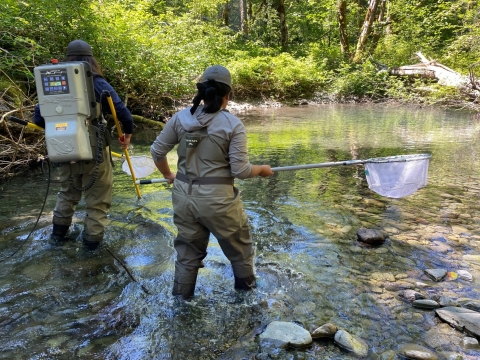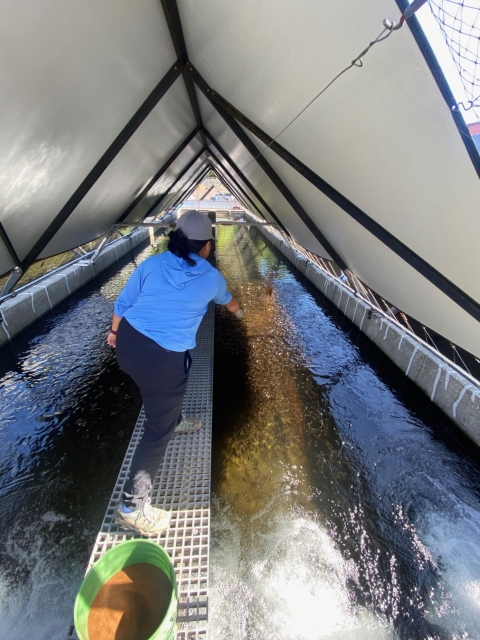I often heard stories of fishermen in the Philippines risking their lives to bring food to the table. In my household, fish and fishing were symbols of survival. As my grandpa would say, “Fish are food, not friends!” While fish are a major food source, I saw them as beings that were trying to survive just as we were. Now, I often find myself waist deep in water to capture fish to study.
Growing up in the Philippines, I was surrounded by beautiful trees and beaches, but they were only accessible to a certain point. I lived in a densely populated city, moving away from the province as I grew older. Immigrating to the States, my parents aspired for me to be in the healthcare field, although I completely deviated from that path to pursue my dreams. I am now on my way to finishing up my bachelor’s degree in environmental science at the University of Texas at San Antonio (UTSA). I chose the environmental route because I wanted to be in a field that was closely attuned to nature and help preserve the planet we live in.
I had my first taste of field work in the summer of 2023, working as an undergraduate research assistant for a professor studying organic matter and porcupine rest sites in San Antonio, Texas. During the hot and humid summer days, a small crew and I collected data on tree composition as well as organic matter in pools that only contain water during abundant rain events. I also had the chance to be an officer for the student subunit of the American Fisheries Society at UTSA and assisted with monthly sampling events at the Guadalupe River. There, I was able to learn how to use a seine net and electrofish in river pools and riffles. It was then that I knew I wanted to pursue a career in the aquatic realm. Now, as a Pathways intern working under the U.S. Fish and Wildlife Service, I’m able to gain hands-on experience in the fisheries world and help sustain our fish and waters.
Throughout my first summer with the Western Washington Fish and Wildlife Conservation Office in Lacey Washington, I was able to be part of multiple projects, including a fish diet study at Lake Washington, electrofishing for sculpin, and some hatchery work with the three National Fish Hatcheries on the Olympic Peninsula. The diet study is investigating the potential predation of salmonid species by non-native fish in this urban lake. We sampled these fish diets by pumping their stomachs with water to extract their stomach contents (“gastric lavage”). In the lab, I learned how to identify invertebrates (species without a backbone) and fish by looking at the anatomy of whatever bones and limbs we could find. I also assisted in eletrofishing for sculpin at multiple rivers in the area. I learned how to identify different sculpin species and use a net in fast-flowing waters. At the hatcheries, I performed fish culture methods such as feeding and assisted in the tagging trailer. Marking and tagging fish help assess the hatchery program in order to make better informed decisions in the future.
Moreover, I had the chance to work with other organizations that specialized in monitoring invasive species invasive species
An invasive species is any plant or animal that has spread or been introduced into a new area where they are, or could, cause harm to the environment, economy, or human, animal, or plant health. Their unwelcome presence can destroy ecosystems and cost millions of dollars.
Learn more about invasive species . I assisted the Lower Elwha Tribe with assessing a polluted estuary for fish populations as well as recording the presence of invasive European green crabs using a giant net. I performed a similar task with one of the members at the office that monitored the presence of European green crabs at Grays Harbor for the Stream Team. I also supported a crew from the Washington Fish and Wildlife Office to capture invasive bullfrogs.
Partnerships were continually relevant during my internship. This exposure showed me the importance of building relationships and maintaining connections over time. These connections helped me gather resources for grad programs, advice on navigating a career in conservation, and generate relationships with people outside of federal government as well. I realize how critical it is to build partnerships to achieve mutual goals and support work being done to help conserve species, now and in the future.
Throughout my internship, I have solidified my pathway of working with aquatic species, fish in particular. I’m able to pave the way into the aquatic conservation field with the goal of protecting our fishes, waters, and environment as a whole. While there is a small representation of Filipino Americans in conservation, I want to showcase that fish are more than just food for the table.











